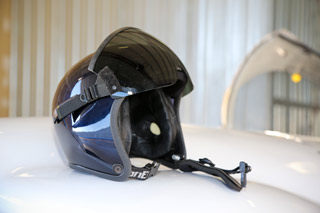 Military aviation helmets are perfectly suited for pointy-nosed jets, but they’ve always been less than ideal in general aviation.
Military aviation helmets are perfectly suited for pointy-nosed jets, but they’ve always been less than ideal in general aviation.
The helmets are too cumbersome for the tight confines of many aerobatic and sport airplanes and tend to scuff narrow canopies. They are relatively heavy (2.5 pounds for the civilian version of an HGU 55), get hot in the summertime, allow too much engine noise to get through—and they’re expensive, with civilianized models easily topping $1,500.
Also, when used without an oxygen mask and visor, the military helmets alone offer scant impact protection. Military helmets were designed to be part of an integrated system that can help crews survive high-speed ejections and other aerial emergencies. But when essential pieces of that system are missing, helmets are little more than extravagant sun-visor holders.
Thankfully, the world of extreme sports is providing general aviation pilots with some excellent alternatives to traditional military flying helmets.
Bonehead Composites, for example, makes an entire line of lightweight skydiving helmets that seem as though they were made with aviation in mind. The company’s Gunar model sells for $225 and fits easily over in-ear headsets (such as Halo or Clarity Aloft) and, at 1.5 pounds, is a full pound lighter than a military helmet. Bonehead also offers attachments for boom mics and oxygen masks, but the basic Gunar model is proving especially popular with aerobatic pilots. (And skydiving helmets are appropriate for the aerobatic crowd, since most of them sit on parachutes and could easily become reluctant skydivers if things go wrong in flight.)
The helmets also are catching on among bush pilots, ag pilots, jump pilots, and backcountry fliers. Some Bonehead models have an optional mount for the seemingly ever-present video cameras that have become everyday flying accessories.
Bonehead founder Chris Frisella built and flies an RV–7 kit aircraft, and he has developed a series of carbon-fiber aircraft parts and accessories separate from the helmets.
Skydiving helmets aren’t a panacea for GA pilots. They provide little noise protection (although noise blocking can be improved with foam inserts), and their usefulness in the case of a hard impact is uncertain. They don’t come with visors like military helmets, but such visors can easily be added, and the visors themselves provide a noticeable improvement in soundproofing.
Still, some impact protection is better than none, and right now most GA pilots fly with no melon safeguards at all. In an age where helmets are ubiquitous among bicyclists, skiers, skateboarders, and others who are moving at far slower speeds than pilots, perhaps we shouldn’t be so hard headed.
Email [email protected]
AOPA Frugal Flier coverage sponsored by Aircraft spruce


